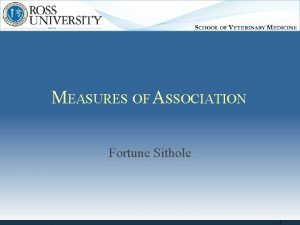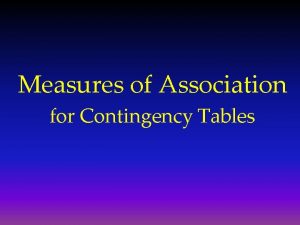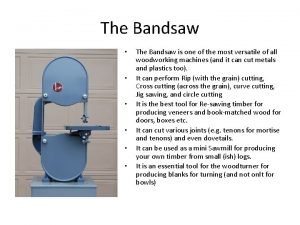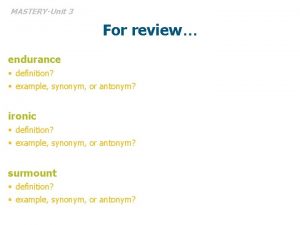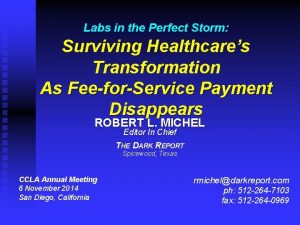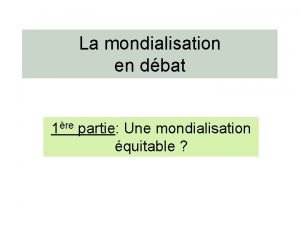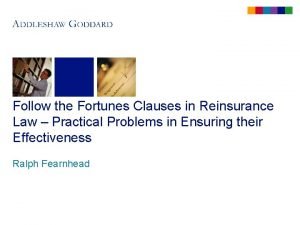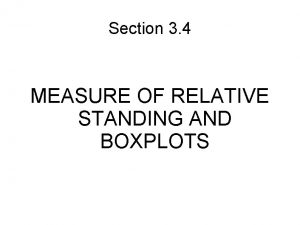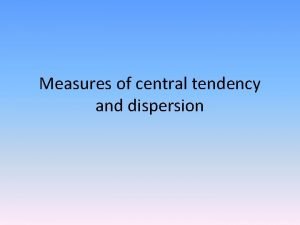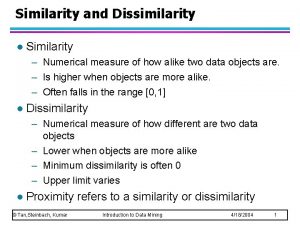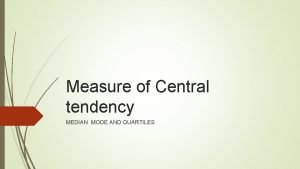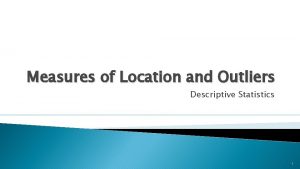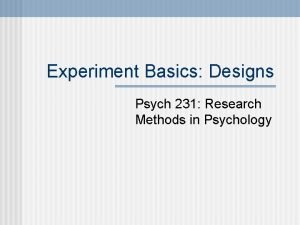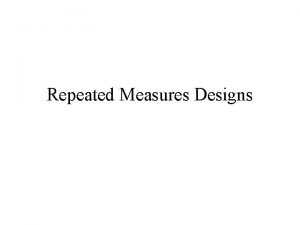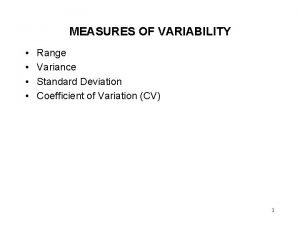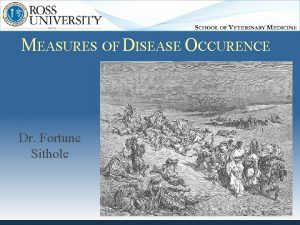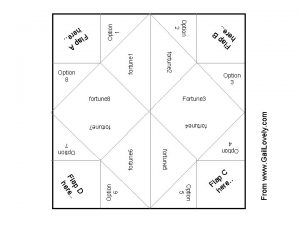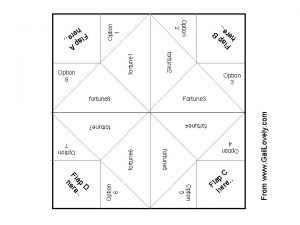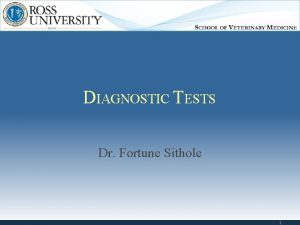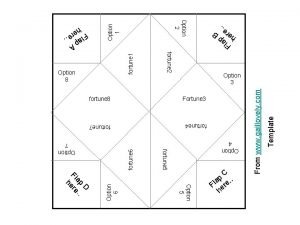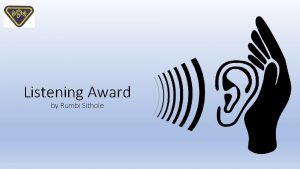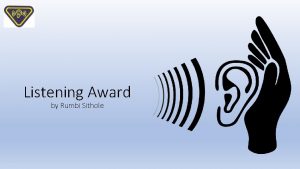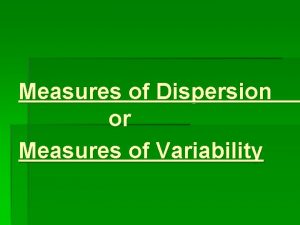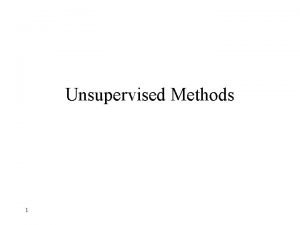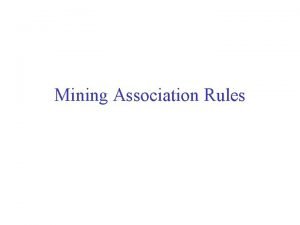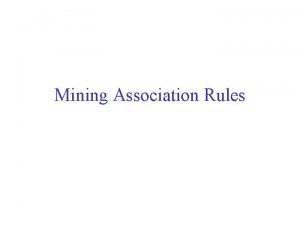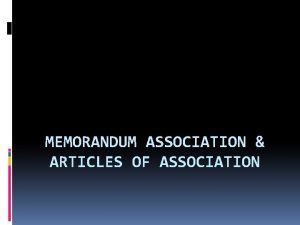MEASURES OF ASSOCIATION Fortune Sithole 1 WHAT IS


































- Slides: 34

MEASURES OF ASSOCIATION Fortune Sithole 1

WHAT IS A MEASURE OF ASSOCIATION AND WHY WE USE THEM

What is a Measures of Association ü Provide a mathematical assessment of the relationship between a given exposure (determinant of dz) and the outcome (dz) of interest ü They do two things: – 1. Determine if there is an association – 2. Measure the “strength of association” ü Used in in Analytical Studies ü Different measures are calculated for different types of studies 3

What is an association? ü An association is any relationship between two measured quantities that renders them dependant ü Dependant (associated)means: When one quantity changes so does the other. – When there is an increase in an exposure there is a corresponding increase the amount of disease – When there is an decrease in an exposure there is a corresponding decrease the amount of disease – When there is an increase in an exposure there is a corresponding decrease the amount of disease – When there is an decrease in an exposure there is a corresponding increase the amount of disease ü Independent (not associated) means: when one quantity changes nothing happens to the other – When there is an increase or decrease in an exposure the amount of disease does not change, it remains the same

What is an association? ü We assume that the exposure IS associated with the disease if: – More dz is found in a groups of subjects that have the exposure than in groups of subject that don’t have the exposure – Less dz is found in a groups of subjects that have the exposure than in groups of subject that don’t have the exposure – More of the exposure is found in groups of dzed subjects than in groups of non-dzed subjects – Less of the exposure is found in groups of dzed subjects than in groups of non-dzed subjects

What is an association? ü We assume that the exposure is NOT associated with the disease if: – The same amount of dz is found in groups of subjects that have the exposure and groups of subject that don’t have the exposure – The same amount of the exposure is found in groups of dzed subjects as in groups of non-dzed subjects

Why Use Measures of Association? We use measures of association to make comparisons: TWO COMPARISONS: 1. Compare exposure groups – Compare the number of animals with the outcome in each exposure group 2. Compare outcome groups – Compare the number of animals with the exposure in each outcome group 7

What is an association anyway? To determine if there is an association between adult body mass and hip dysplasia you enrol: 100 small breed puppies 100 large breed puppies Follow them for life There is an association if: 1. There are more cases of hip dysplasia in the large dogs 2. There are less cases of hip dysplasia in the large dogs There is no association if: 1. Both groups have the same number of cases 8

What is an association anyway? To determine if there is an association between renal failure and Advantage II flea tx you enrol: 126 cats with renal failure 163 cats no renal failure Ask if they used Advantage BUT what if the number in the groups are different? There is an association if: 1. More cats with renal failure received Advantage 2. Fewer cats with renal failure received Advantage There is no association if: 1. The same number of cats received Advantage in both groups 9

The number of subjects in the groups is almost never the same • We cannot just count the number of animals in each group that have used Advantage • We use measures of dz occurrence: Prevalence Incidence (Risk) and odds to calculate measures of association 10

DIFFERENT MEASURES OF ASSOCIATION 11

Measures of Association We will cover these measures of association: 1. Odds Ratio 2. Relative Risk also called the Incidence Ratio 3. Prevalence Ratio 12

Where Measures of Association Are Used 1. Compare exposure in dzed groups (dzed vs non-dzed) – Retrospective studies • • • Odds Ratio Cross-sectional studies Case-control studies 2. Compare dz in exposure groups (exposed vs non-exposed) A. Prospective studies • • • B. • • • Relative Risk (Incidence ratio) Prospective cohort studies Clinical Trials Retrospective Studies Prevalence ratio Retrospective cohort studies Cross sectional 13

1. Compare exposure in dzed groups (dzed vs non-dzed groups) ü Remember: in case-control and cross-sectional studies, the exposure and disease have already occurred when the study begins – Cannot measure incidence ü Case-control studies cannot estimate prevalence in the population, but they can determine the association between exposure and disease ü Cross-sectional studies estimate prevalence but can also evaluate exposures… if exposure data are collected as part of the study! 14

1. Compare exposure in dzed groups (dzed vs non-dzed groups) Odds is used to measure exposure in the dzed and non-dzed groups Odds is the ratio of the number exposed to the number not exposed Odds = Number exposed/Number not exposed If there were 10 dzed animals and 3 of them were exposed: The odds of exposure in the dzed group would be = 3/7 15

1. Compare exposure in dzed groups (dzed vs non-dzed groups) Odds Ratio is the ratio of the Odds of exposure in dzed to the Odds of exposure in the non-dzed Odds Ratio = Odds of Exposure in the dzed Odd of Exposure in the non-dzed 16

Interpreting the Odds Ratio “The Odds of being exposed was ____ times as high in diseased animals as in non-diseased animals” Odds Ratio = Odds of Exposure in the dzed Odd of Exposure in the non-dzed ü If OR=1 – Odds of exposure among cases was equal to that of controls – No association ü If OR>1 – Odds of exposure among cases was greater than that of controls – Positive association, possibly causal ü If OR<1 – Odds of exposure among cases was less than that of controls – Negative association, possibly protective OR tells you if there is an association and the magnitude of the association 17

Calculating the Odds Ratio Use a two by Two Table OR = (ad)/(bc) Case Dzed Control Non-Dzed Exposed a b Unexposed c d 18

Calculating the Odds Ratio Use a two by Two Table OR = (ad)/(bc) OR is called the “Cross Product Ratio” Because you multiply diagonally which forms an X Case Dzed Control Non Dzed Exposed a b Unexposed c d 19

Calculating the Odds Ratio To measure the association between wet food and myocarditis, 50 dogs with myocarditis were matched with 100 healthy controls. Owners were questioned about their dogs dietary history. 10 of the healthy dogs and 20 of the dogs with mycodarditis ate wet food. What is the measure of association? Cases Myocarditis Controls Healthy Wet 20 a 10 b Dry c 30 d 90 Total 50 100 OR = (ad)/(bc) OR = (20*90)/(10*30) OR = (1800)/(300) OR = 6 Dogs with myocarditis had a 6 times greater odds of eating wet food 20

2. Compare dz in exposure groups a) Prospective studies Incidence (called risk)is the measure used to compare the amount of dz that occurs in the exposed and unexposed groups in prospective studies – Risk (Incidence) is used because the exposed and unexposed are non-dzed at the beginning of the study ü Cumulative incidence (attack rate, risk) – Number of new cases at the end of the study, divided by the population at risk at the beginning of the study – If there were 10 healthy exposed animals and 3 of them developed dz: • The risk of dz in the exposed group would be = 3/10 ü Incidence density – Number of new cases at the end of the study, divided by animal-time at risk – If there were 10 healthy animals exposed for 20 months each and 3 of them developed dz: – The incidence density in the exposed group would be = 3/200 animal-months 21

2. Compare dz in exposure groups a) Prospective studies Relative Risk is used to compare the Risk(incidence) of disease that occurs in the exposed and unexposed groups – It is the ratio of incidence of dz in the exposed to the incidence of dz in the unexposed Relative Risk = Risk (Incidence) of dz in Exposed Risk (Incidence) of dz in un-Exposed 22

Interpreting the Relative Risk “The risk (incidence) of disease is ____ times as high in exposed animals as in unexposed animals” Relative Risk = Risk (Incidence) of dz in Exposed Risk (Incidence) of dz in un-Exposed ü If RR=1 – The risk of disease in the exposed group is equal to the risk in the unexposed group – No association ü If RR>1 – The risk of disease in the exposed group is greater than the risk in the unexposed group – Positive association, possibly causal ü If RR<1 – The risk of disease in the exposed group is less than the risk in the unexposed group – Negative association, possibly protective 23

Calculating Relative Risk Use a two by two table RR = Disease No disease Risk (Incidence) Exposed a b a/(a+b) Unexposed c d c/(c+d) a/(a+b) c/(c+d) Relative Risk = Risk (Incidence) of dz in Exposed Risk (Incidence) of dz in un-Exposed 24

Calculating Relative Risk To measure the association between wet food and myocarditis, 100 healthy dogs that ate wet food and 200 healthy dogs that did not were followed for 5 years. 15 of the dogs that ate wet food and 20 of the dogs that ate dry dog food developed myocarditis. What is the measure of association? RR = a/(a+b) c/(c+d) Myocarditis Healthy Total Risk (Incidence) Wet a 15 b 85 a+b 100 15/100 = 0. 15 Dry c 20 d 180 c+d 200 20/200 = 0. 10 15/(15+85) 20/(20+180) 0. 15 0. 10 RR = 1. 5 Dogs that ate wet dog food were 1. 5 times more likely to develop myocarditis 25

2. Compare dz in exposure groups a) Retrospective studies Prevalence is the measure used to compare the amount of dz that occurred in the exposed and unexposed groups in retrospective studies – Prevalence is used because the disease has already occurred when the study has begun ü Prevalence – The probability of being diseased – The number of diseased divided by the total number exposed ü If there were 10 exposed animals and 3 of them were dzed: – The prevalence of dz in the exposed group would be = 3/10 26

2. Compare dz in exposure groups a) Retrospective studies Prevalence Ratio is used to compare the Prevalence of disease that occurred in the exposed and unexposed groups in retrospective studies – It is the ratio of prevalence of dz in the exposed to the prevalence of dz in the unexposed Prevalence Ratio = Prevalence of dz in Exposed Prevalence of dz in un-Exposed 27

Interpreting Prevalence Ratios “The prevalence of disease was ____ times as high in exposed animals as in unexposed animals” Prevalence Ratio = Prevalence of dz in Exposed Prevalence of dz in un-Exposed ü If PR=1 – The prevalence of disease in the exposed group was equal to the prevalence in the unexposed group – No association ü If PR>1 – The prevalence of disease in the exposed group was greater than the prevalence in the unexposed group – Positive association, possibly causal ü If PR<1 – The prevalence of disease in the exposed group was less than the prevalence in the unexposed group – Negative association, possibly protective 28

Calculating Prevalence Ratios Use a two by two table PR = Disease No disease Prevalence Exposed a b a/(a+b) Unexposed c d c/(c+d) a/(a+b) c/(c+d) Prevalence Ratio = Prevalence of dz in Exposed Prevalence of dz in un-Exposed 29

Calculating Prevalence Ratios To measure the association between wet food and myocarditis, 100 dogs that ate wet food and 200 dogs that did not were selected and their medical records checked to see if they had previously been diagnosed with myocarditis. 15 of the dogs that ate wet food and 20 of the dogs that ate dry dog food had myocarditis in the past. What is the measure of association? PR = a/(a+b) c/(c+d) Myocarditis Healthy Total Risk (Incidence) Wet a 15 b 85 a+b 100 15/100 = 0. 15 Dry c 20 d 180 c+d 200 20/200 = 0. 10 15/(15+85) 20/(20+180) 0. 15 0. 10 PR = 1. 5 Dogs that ate wet dog food were 1. 5 times more likely to have developed myocarditis 30

Measures of Disease and Association Study Design Measure of Disease/Exposure Measure of Association None Various Prevalence/Odds PR/OR Odds OR Prospective Cohort Incidence RR, OR Retrospective Cohort Prevalence PR, OR Clinical Trial Incidence RR Case Report /Series Ecological Cross Sectional Case-Control 31

MEASURES OF EFFECT

Attributable Risk ü Attributable risk (AR) (Etiologic fraction) – How much of the disease is attributed to the factor in the study sample? ü Population attributable risk (ARpop) – How much of the disease in the target population is attributed to the factor? 33

Calculating Attributable Risk To measure the association between wet food and myocarditis, 100 healthy dogs that ate wet food and 200 healthy dogs that did not were followed for 5 years. 15 of the dogs that ate wet food and 20 of the dogs that ate dry dog food developed myocarditis. How much of the risk is due to wet dog food? Myocarditis Healthy Risk (Incidence) Wet a 15 b 85 15/(100) = 0. 15 Dry c 20 d 180 20/200 = 0. 10 0. 33 (33% ) of the myocarditis in the dogs eating wet dog food was attributed to wet dog food 34
 Fortune sithole
Fortune sithole Repeated measures design vs independent measures design
Repeated measures design vs independent measures design Ukuran asosiasi epidemiologi
Ukuran asosiasi epidemiologi Measures of association
Measures of association What was the great chain of being in macbeth
What was the great chain of being in macbeth Sergei dyadechko fortune
Sergei dyadechko fortune How to change your fortune
How to change your fortune When in disgrace with fortune and men's eyes meaning
When in disgrace with fortune and men's eyes meaning Ciruela fortune
Ciruela fortune Michael fortune bandsaw
Michael fortune bandsaw Example synonym
Example synonym Ilnet fortune
Ilnet fortune Disdaining fortune
Disdaining fortune Romeo and juliet jeopardy
Romeo and juliet jeopardy Out your
Out your Companion diagnostic
Companion diagnostic Fortune magazine
Fortune magazine Follow the fortunes clause
Follow the fortunes clause Ted's flight from amsterdam
Ted's flight from amsterdam Rex fortune elementary school
Rex fortune elementary school Fortune 500 api
Fortune 500 api Justice involved supportive housing
Justice involved supportive housing Ami core measures
Ami core measures Divergence measures and message passing
Divergence measures and message passing Measures of relative standing and boxplots
Measures of relative standing and boxplots Measures of central tendency and variation
Measures of central tendency and variation Repeated measures design psychology
Repeated measures design psychology Measures of effective teaching project
Measures of effective teaching project Measure of central tendency and dispersion
Measure of central tendency and dispersion Similarity and dissimilarity measures in data mining
Similarity and dissimilarity measures in data mining Measures of central tendency median
Measures of central tendency median Measures of location
Measures of location Iv and dv in research
Iv and dv in research Repeated measures
Repeated measures How to interpret standard deviation results
How to interpret standard deviation results
